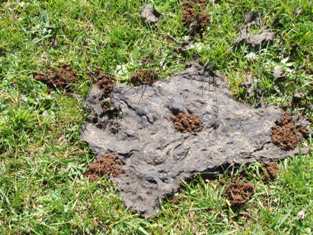Dung Beetles

Dung Beetle Activity at Wagner Road, Neerim South
Dung Beetle Activity at Wagner Road, Neerim South
For every 100 head of cattle there is a potential loss of 387 kg of Nitrogen and 108kg of Phosphorous per annum. These figures reflect the nutrient loss that occurs
from unburied dung and natural return to the soil through leaching and weathering, which is estimated to account for 24 to 34 per cent of the deposited dung
Dung burial allows these nutrients to be incorporated into the soil at the plant-root zone where microbial activity makes them readily available to plants – leading to healthier pastures and improved meat/milk production. Dung burial also reduces the quantity of nutrients and other organic matter from entering our river systems by an estimated 15%. Such run-off chemicals can increase the incidence of algal blooms in aquatic environments.
Putting a dollar value on the potential benefits of an efficient dung beetle population is a relatively simple exercise- for every 100 head of cattle, unburied dung is equivalent to the cost of approximately 0.8 of a tonne of Urea and 1.2 tonnes of Single super per annum. Add to this the expense of parasiticides to control pest species which live, breed and feed in the dung, and the price paid for a colony of introduced beetles is clearly worth every cent.
*The information used to obtain these figures comes from studies by Richard Eckard and Malcolm McCaskill; Lott, Powell and Sweeten, and the Victorian College of Agriculture and Horticulture.
Article from John Feehan – SOILCAM
To find out more information on dung beetles please visit:
